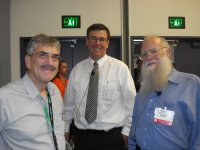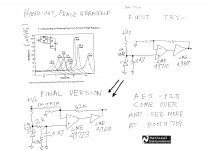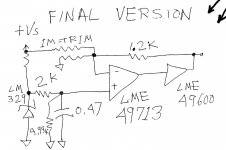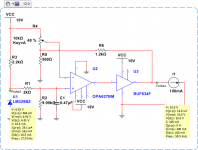Hi Kevinkr,
I am surprised those are in your SACD player. Which player is it? Which LME opamp did they use? LME49710's or 713's? Are they the metal can HA parts?
Audioman54 / Mark
I put them in there as I can't leave anything well enough alone.. They are LME 49720 in metal cans, I previously had LM4562 in there. The original devices were faster, but had some issues sonically speaking. The player is a Sony SCD-777ES which I have modified extensively. Currently I pick the audio off of the differential I/V outputs and feed that to a transformer for balanced to unbalanced conversion.
I tend to get contacted for local jobs, not so much stuff on the West Coast..
(bold mine)One unit had all metal can LME Opamps and the other one had all plastic dip LME Opamps. We matched the output levels of both D/A preamps to within 1dB and then sealed up the units and labeled them A and B. I then switched out the externally identical units and Bob listened to them in our sound room at National.
Is this a typo? For a fair comparsion differences less than 0.1dB would be minimum requirement and actually 0.01dB (0.1%) wideband matching should be readily achievable with preamps using the nominally identical opamps and some fine gain trimming.
Hi Mark
In that graph you show of the preamp distortion changes before and after your power supply mod in Post 2111, I'm guessing the red line is pre-mod and the blue line post mod but can you pleased confirm that?
The red line has harmonics of the 2kHz test signal out to the fifth. The blue line doesn't seem to have any harmonics at all above -124 dB, but the noise floor is about 8 dB higher than the red line (unless you've deliberately offset the two lines for clarity).
Am I reading this right? Have you created a distortionless preamp, or at least one with no distortion above -124 dB? Also, does the plot show that the distortion products visible in the red line are as a result of the power supply rather than the op-amp itself?
In that graph you show of the preamp distortion changes before and after your power supply mod in Post 2111, I'm guessing the red line is pre-mod and the blue line post mod but can you pleased confirm that?
The red line has harmonics of the 2kHz test signal out to the fifth. The blue line doesn't seem to have any harmonics at all above -124 dB, but the noise floor is about 8 dB higher than the red line (unless you've deliberately offset the two lines for clarity).
Am I reading this right? Have you created a distortionless preamp, or at least one with no distortion above -124 dB? Also, does the plot show that the distortion products visible in the red line are as a result of the power supply rather than the op-amp itself?
Last edited:
Am I reading this right? Have you created a distortionless preamp, or at least one with no distortion above -124 dB?
no big deal for quite some time now using recent op amps, composite topologies
Hi Carl,
Not quite ready to publish those changes yet...but if anyone can find the video of the AES presentation in SF with Bob and I that we gave together on Sat Oct 4th 2008, that presentation has 95% of the changes in that video. Let the hunt for the video begin!
Was anyone from DIY at that presentation? I thought you were there Carl?
Audioman54 / Mark
I was there Mark; I'll look through my pics I may have a picture of (some) of the schematics.
Jan
...
The red line has harmonics of the 2kHz test signal out to the fifth. The blue line doesn't seem to have any harmonics at all above -124 dB, but the noise floor is about 8 dB higher than the red line ...
I´m not Mark, but to me it appears that the red line simply superimposes
the blue one (if you look at the third, it´s slightly violett on top),
this would indicate red and blue have the same distortion but red has the
lower noise floor.
Thanks jan.diden 
First I want to ask Mark if I have his permission to upload this, If you think I shouldn't I'll remove it.
I kept the values for the positive reference, and I played with the values and configurations for R4 and R5. First I though that it was a good idea to change R1 and R2, but then I realize that those are very important, and I shouldn't change those values.
I choose BUF634 because it was the only one that I could find on the multisim library, and I have some too.
First I want to ask Mark if I have his permission to upload this, If you think I shouldn't I'll remove it.
I kept the values for the positive reference, and I played with the values and configurations for R4 and R5. First I though that it was a good idea to change R1 and R2, but then I realize that those are very important, and I shouldn't change those values.
I choose BUF634 because it was the only one that I could find on the multisim library, and I have some too.
Attachments
Hi Everyone,
gk7 you are correct about the two lines being the same at the one bad peak. Later on I was able to reduce that weird peak. If I had a good analyzer (still looking for something like an AP2 or the Stanford Instruments one which is almost/95% as good if anyone wants to sell a used one) then I could post some new graphs with a slightly better D/A chip from AKM in the box I listen to at home. I used to be able to go back into TI but all the AP's were shipped to TX when the Audio Group was eliminated. By the way those two red and blue lines were actual measurements on the same unit before and after the change. There were no games played with offsets, those were the actual measurements.
Jan Thanks for posting that Pic of all three of us. I know you sent that pic to me and I have it somewhere...but now it will be easy to find as I saved it in my audio folder.
The schematic that was hand drawn by Bob is correct...however it is phase one and it does not have the changes that resulted in the 6dB or so lower THD+N graph that I posted. If somebody on this forum finds me a contact that leads to a job then I will post the final change. It was something that is not obvious but very simple and I had never seen it in an audio circuits book before. Bob had a memory like an encyclopedia but he could not remember where he saw the change...he just knew it would work...and it did!
Off to work on a broken set of AR Hi Res speakers for my oldest son in TX.
Sure is fun being back on the DIY Forum. Sorry I missed the show this year. My best buddy Benchtester went but he did not show any of the "New Stuff" we are working on. Hopefully next year.
Audioman54 / Mark
gk7 you are correct about the two lines being the same at the one bad peak. Later on I was able to reduce that weird peak. If I had a good analyzer (still looking for something like an AP2 or the Stanford Instruments one which is almost/95% as good if anyone wants to sell a used one) then I could post some new graphs with a slightly better D/A chip from AKM in the box I listen to at home. I used to be able to go back into TI but all the AP's were shipped to TX when the Audio Group was eliminated. By the way those two red and blue lines were actual measurements on the same unit before and after the change. There were no games played with offsets, those were the actual measurements.
Jan Thanks for posting that Pic of all three of us. I know you sent that pic to me and I have it somewhere...but now it will be easy to find as I saved it in my audio folder.
The schematic that was hand drawn by Bob is correct...however it is phase one and it does not have the changes that resulted in the 6dB or so lower THD+N graph that I posted. If somebody on this forum finds me a contact that leads to a job then I will post the final change. It was something that is not obvious but very simple and I had never seen it in an audio circuits book before. Bob had a memory like an encyclopedia but he could not remember where he saw the change...he just knew it would work...and it did!
Off to work on a broken set of AR Hi Res speakers for my oldest son in TX.
Sure is fun being back on the DIY Forum. Sorry I missed the show this year. My best buddy Benchtester went but he did not show any of the "New Stuff" we are working on. Hopefully next year.
Audioman54 / Mark
Level matching for double blind testing
KTSR I forgot to reply to your question about level matching. All our Demo D/A preamp units were identical and probably within less than .1dB level matching. Our hand held meter in the sound rood had 1dB increments and we used it as a backup system of verifying our initial electrical measurements were correct, i.e. when we started actually listening we wanted to verify we were close to where we should be in the sound room. I know we were well within .1dB and probably better. I don't believe .01 is necessary for these kinds of listening tests.
I have specific things I listen for during these listening/testing sessions some of which are normal music and some are just sounds/test signals. I also have a few recordings that I use in my listening tests where I was present at the recording session.
Some things are so obvious level does not matter but for most listening tests I agree that level matching is critical.
Audioman54 / Mark
KTSR I forgot to reply to your question about level matching. All our Demo D/A preamp units were identical and probably within less than .1dB level matching. Our hand held meter in the sound rood had 1dB increments and we used it as a backup system of verifying our initial electrical measurements were correct, i.e. when we started actually listening we wanted to verify we were close to where we should be in the sound room. I know we were well within .1dB and probably better. I don't believe .01 is necessary for these kinds of listening tests.
I have specific things I listen for during these listening/testing sessions some of which are normal music and some are just sounds/test signals. I also have a few recordings that I use in my listening tests where I was present at the recording session.
Some things are so obvious level does not matter but for most listening tests I agree that level matching is critical.
Audioman54 / Mark
most use 1% metal film feedback R, seldom check - worst case stackup with diff summer or series biquad gain blocks can easily exceed the 0.1 dB jnd level matching threshold
even audio DAC channels are often speced at ~ 1% gain match
and while low closed loop gains, high feedback op amp circuits usually have plenty of excess feedback loop gain - it seems likely some naive comparisons of 15-20 dB loop gain audiophile amps vs "high loop gain" circuits do vary in closed loop gain due to lack of loop gain
even audio DAC channels are often speced at ~ 1% gain match
and while low closed loop gains, high feedback op amp circuits usually have plenty of excess feedback loop gain - it seems likely some naive comparisons of 15-20 dB loop gain audiophile amps vs "high loop gain" circuits do vary in closed loop gain due to lack of loop gain
Are the jobs you are seeing located in the SF Bay Area?
Maybe 1audio can help you as he is looking for a tech in SF Bay Area...see http://www.diyaudio.com/forums/equi...n-audio-range-oscillator-320.html#post3700996
Hi aparatusonitus,
Thanks for checking that out for me!...but I have known 1Audio (Demian) for quite some time now. We have actually worked on several projects together. He is just across the bay from me. I also have one of his orig prototype Auraliti units...which is non-functional right now and I have talked with him about getting together and getting it fixed.
I like playing with 24/192 source material from the Auraliti's digital out into my LME D/A preamp. (I wish I could get Golden String Recordings/FIM to release the "All Star Percussion Ensemble" as a 24/192 file as it is my favorite test disk...and it is fun to listen to also!)
Thanks Again!
Mark / Audioman54
Thanks for checking that out for me!...but I have known 1Audio (Demian) for quite some time now. We have actually worked on several projects together. He is just across the bay from me. I also have one of his orig prototype Auraliti units...which is non-functional right now and I have talked with him about getting together and getting it fixed.
I like playing with 24/192 source material from the Auraliti's digital out into my LME D/A preamp. (I wish I could get Golden String Recordings/FIM to release the "All Star Percussion Ensemble" as a 24/192 file as it is my favorite test disk...and it is fun to listen to also!)
Thanks Again!
Mark / Audioman54
Over the past several weeks I have been trying several opamps in my WM8740-based DAC and I will offer my impressions of them for this purpose:
1) OP275 - This is the opamp that was included with the DAC. Warm and smooth, but boringly so. Flat.
2) AD8599 - Generally good, with decent sound stage, but the top end is too hot and seems slightly distorted. Not "real" sounding.
3) OPA2132 - Very nice and well-balanced. Great bass. Warm, but not overly so. Slightly receded highs make for less forward sound and slightly narrower sound stage than AD8599, but still far more pleasurable to listen to.
4) OPA2107 - All the same great sound as the 2132, except the top end is better and the sound stage and imaging are improved. Perhaps slightly less bass? Either way, I really like this one. If I had not tried #5 below, this would be my opamp.
5) AD8066 - Thick, but fast bass. Incredible treble extension. Excellent mids. Sounds extremely accurate and fast. The sound stage and stereo separation seems twice as wide as any of the others and the imaging just blows my mind.
You can probably guess that the AD8066 is my current favourite. I generally like the "warmer Burr Brown sound", but I am running tube amplification, so I get plenty of warmth from that.
I find the combination of a fast, clean, crisp, accurate (analytical?) source with tube amplification and single-driver full range speakers to be very potent and impressive!
I may switch back to the OPA2107 and/or OPA2132 at some point just to hear the difference once again, but I think the AD8066 has found a permanent home in my DAC.
Several system changes later and I am finding I am really enjoying the AD8599 these days. The "too hot" and/or "distorted" top end must have been an artifact of something else in my setup at the time. Going to do some more rolling and listening again soon....
I just got through the last several pages of the thread, and I am now very interested in trying the LME49720 metal cans. What is the best way to ensure I obtain a genuine part? Mouser?
Why would you think that going to Farnell or Newark or RS wouldn't get you a genuine part? If you are really worried then pay for sample from TI, and they'll send them to you.
But if the 49720 is the number I remember with the LM4562, then I think you can hold your breath on musicality. Brilliant and perfect in lots of ways but not great in an average setting. (I take mine to be an average setting since I made no changes between uses - which frankly should be done with each chip to let it do its best.) It will hold you for two or three days, but after that you will be done with it. It is a crackly form of perfection. I desperately wanted it to work but I ditched it. It lived up to all its promises but I still had to ditch it.
I hope that helps. (And please don't let me stop you from getting whatever you need to. I wouldn't have wanted to miss the experience.)
Hi Christian,
I very much appreciate the weight of your post and your insight.
I have been doing a lot of thinking about DSP, DACs, opamps lately. A new pair of drivers have re-ignited my passion. Shortly after getting the drivers, I decided to begin rolling through my opamps again. I pulled the AD8066 and replaced it with the AD8599 and found the energy level, bass speed, etc. refreshing. For the past few weeks, my whole family has enjoyed the AD8599 while the new drivers burn in.
Then I started thinking, reading, and talking about opamps again in the last 48 hours or so. I decided to spend some time this evening with the OPA2107. Very glad I did. This is an opamp that I did not pay much attention to when I got it. I was probably swayed by something I read on the internet. Anyway, it has really impressed both my wife and I this evening. The AD8599 is very energetic and dynamic and it completes the full audio spectrum, but (at least in the circuit I am running) it seems a bit unrefined. I only noticed it once in a while over the past few weeks, so I was forgiving. Tonight has changed my perspective. The OPA2107 has just as broad of a spectrum, but with more grace. Extreme detail, but without the slight edge of the AD. Perhaps the OPA has very slightly less 3D imaging, but that isn't a fatal flaw. I need to spend more time with it...
I very much appreciate the weight of your post and your insight.
I have been doing a lot of thinking about DSP, DACs, opamps lately. A new pair of drivers have re-ignited my passion. Shortly after getting the drivers, I decided to begin rolling through my opamps again. I pulled the AD8066 and replaced it with the AD8599 and found the energy level, bass speed, etc. refreshing. For the past few weeks, my whole family has enjoyed the AD8599 while the new drivers burn in.
Then I started thinking, reading, and talking about opamps again in the last 48 hours or so. I decided to spend some time this evening with the OPA2107. Very glad I did. This is an opamp that I did not pay much attention to when I got it. I was probably swayed by something I read on the internet. Anyway, it has really impressed both my wife and I this evening. The AD8599 is very energetic and dynamic and it completes the full audio spectrum, but (at least in the circuit I am running) it seems a bit unrefined. I only noticed it once in a while over the past few weeks, so I was forgiving. Tonight has changed my perspective. The OPA2107 has just as broad of a spectrum, but with more grace. Extreme detail, but without the slight edge of the AD. Perhaps the OPA has very slightly less 3D imaging, but that isn't a fatal flaw. I need to spend more time with it...
Last edited:
- Home
- Amplifiers
- Chip Amps
- The best sounding audio integrated opamps



